- Главная
- Разное
- Бизнес и предпринимательство
- Образование
- Развлечения
- Государство
- Спорт
- Графика
- Культурология
- Еда и кулинария
- Лингвистика
- Религиоведение
- Черчение
- Физкультура
- ИЗО
- Психология
- Социология
- Английский язык
- Астрономия
- Алгебра
- Биология
- География
- Геометрия
- Детские презентации
- Информатика
- История
- Литература
- Маркетинг
- Математика
- Медицина
- Менеджмент
- Музыка
- МХК
- Немецкий язык
- ОБЖ
- Обществознание
- Окружающий мир
- Педагогика
- Русский язык
- Технология
- Физика
- Философия
- Химия
- Шаблоны, картинки для презентаций
- Экология
- Экономика
- Юриспруденция
Что такое findslide.org?
FindSlide.org - это сайт презентаций, докладов, шаблонов в формате PowerPoint.
Обратная связь
Email: Нажмите что бы посмотреть
Презентация на тему Экологические проблемы в Казахстане
Содержание
- 2. Environmental problems of our Republic:The Aral Sea’s problemThe Caspian Sea’s problemAtmospheric pollutionWind erosionSemipalatinsk nuclear test siteP.S.
- 3. The Aral Sea’s problemCurrently, humanity has plenty
- 4. The Caspian Sea’s problemThe Caspian Sea is
- 5. Atmospheric pollutionEnvironmental pollution, especially atmospheric pollution, is
- 6. Wind erosionWind erosion has also had an
- 7. Semipalatinsk nuclear test siteThe gravest environmental threat
- 9. Скачать презентацию
- 10. Похожие презентации
Environmental problems of our Republic:The Aral Sea’s problemThe Caspian Sea’s problemAtmospheric pollutionWind erosionSemipalatinsk nuclear test siteP.S.
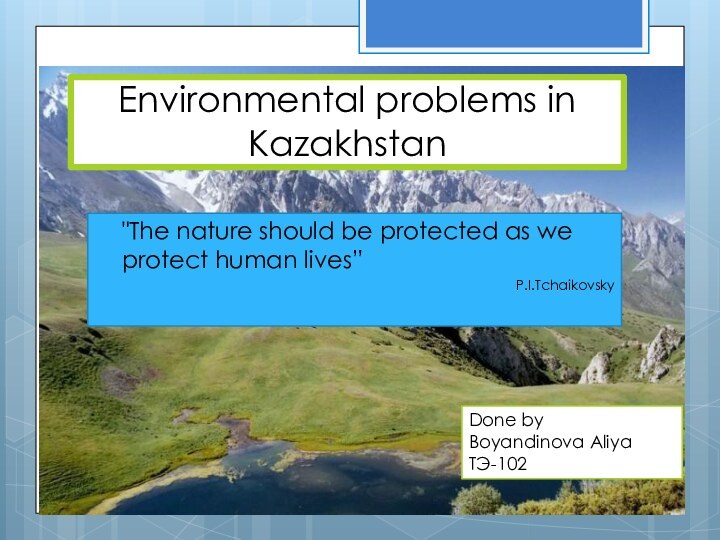
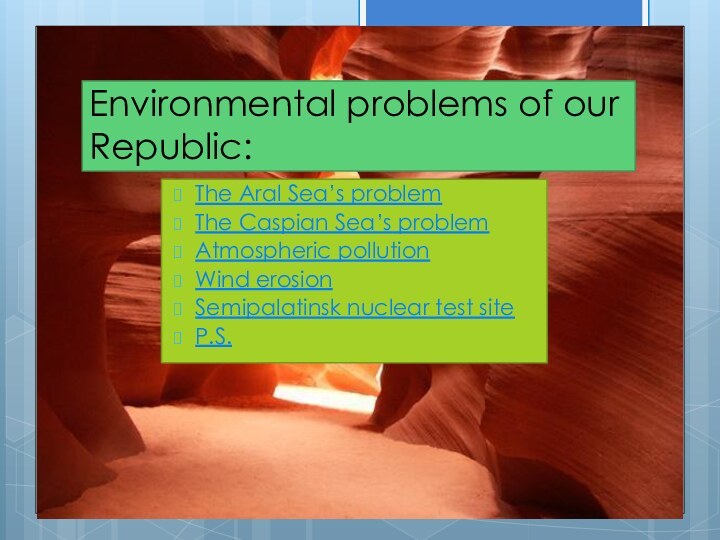
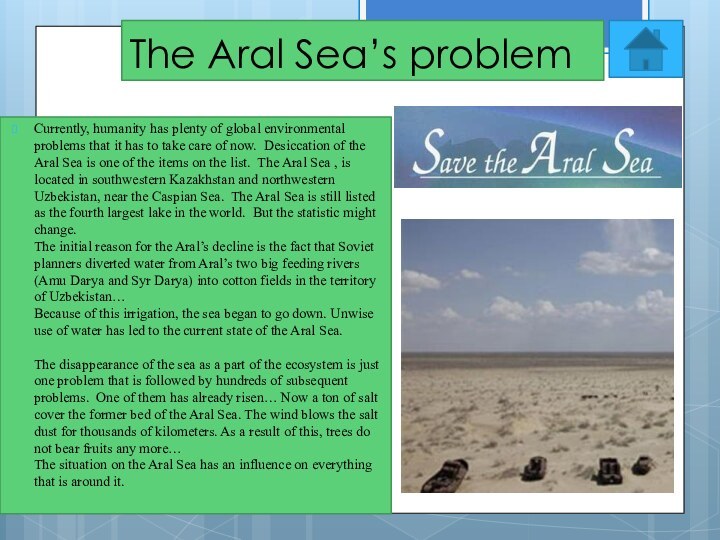
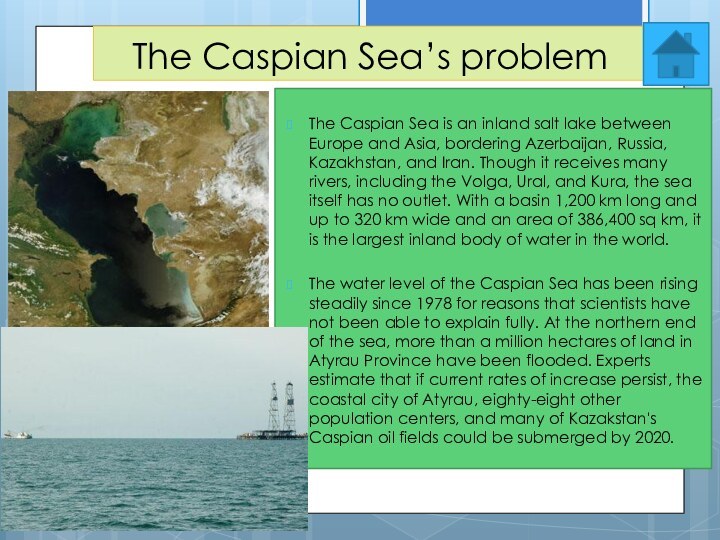

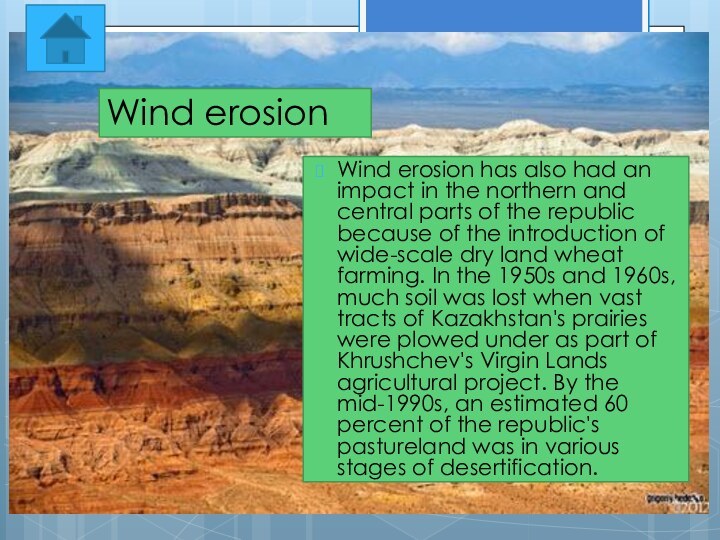
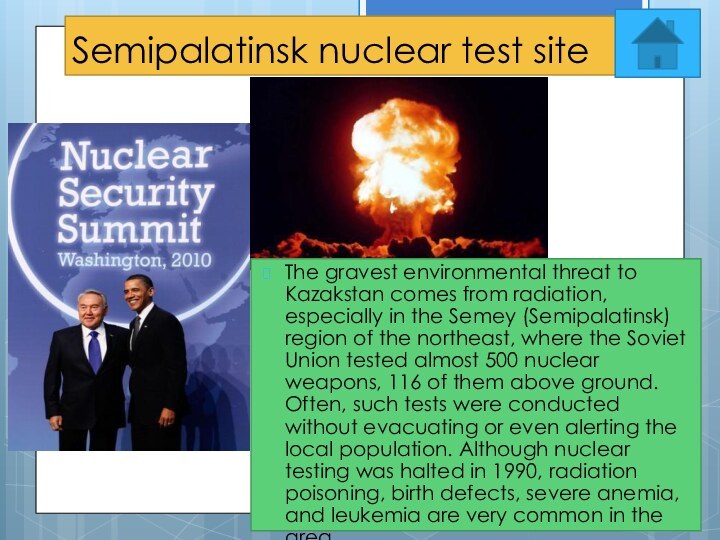


Слайд 3
The Aral Sea’s problem
Currently, humanity has plenty of
global environmental problems that it has to take care
of now. Desiccation of the Aral Sea is one of the items on the list. The Aral Sea , is located in southwestern Kazakhstan and northwestern Uzbekistan, near the Caspian Sea. The Aral Sea is still listed as the fourth largest lake in the world. But the statistic might change. The initial reason for the Aral’s decline is the fact that Soviet planners diverted water from Aral’s two big feeding rivers (Amu Darya and Syr Darya) into cotton fields in the territory of Uzbekistan… Because of this irrigation, the sea began to go down. Unwise use of water has led to the current state of the Aral Sea. The disappearance of the sea as a part of the ecosystem is just one problem that is followed by hundreds of subsequent problems. One of them has already risen… Now a ton of salt cover the former bed of the Aral Sea. The wind blows the salt dust for thousands of kilometers. As a result of this, trees do not bear fruits any more… The situation on the Aral Sea has an influence on everything that is around it.
Слайд 4
The Caspian Sea’s problem
The Caspian Sea is an
inland salt lake between Europe and Asia, bordering Azerbaijan,
Russia, Kazakhstan, and Iran. Though it receives many rivers, including the Volga, Ural, and Kura, the sea itself has no outlet. With a basin 1,200 km long and up to 320 km wide and an area of 386,400 sq km, it is the largest inland body of water in the world.The water level of the Caspian Sea has been rising steadily since 1978 for reasons that scientists have not been able to explain fully. At the northern end of the sea, more than a million hectares of land in Atyrau Province have been flooded. Experts estimate that if current rates of increase persist, the coastal city of Atyrau, eighty-eight other population centers, and many of Kazakstan's Caspian oil fields could be submerged by 2020.
Слайд 5
Atmospheric pollution
Environmental pollution, especially atmospheric pollution, is another
urgent problem in Kazakhstan. In some big cities and
industrial centers concentrations of some toxic substances, such as heavy metal dust, sulfur dioxide, carbon oxide, and some others, are greater by tens of time than maximum permissible concentrations (MPC). The most acute situation is typical of the cities Taraz, Temirtau, Almaty, Oskemen, Leninogor, Shymkent, Balkash, and some others. Pollutant concentrations in these cities within a year are by 5 to 10 times greater than MPC.Atmospheric air is significantly polluted in the regions, where mineral resources are exploited. Air pollution results also from spaceships launching at the Baikonur space center.
Apart from air pollution there is also pollution of surface waters and other components of the biosphere in the industrially developed regions.
The industrial pollution is aggravated by large-scale chemical pollution caused by agriculture. Various chemical means for plant protection, defoliants, pesticides, and excessive fertilizers pollute both environmental and foodstuffs.





























